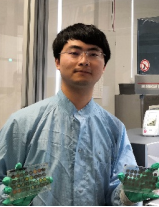High-throughput engineering and interpretable machine learning for stable metal-halide perovskite materials
Zhao Yicheng
Helmholtz-Institute Erlangen-Nürnberg (HI-ERN), Immerwahrstraße 2, 91058 Erlangen, Germany
EXTENDED ABSTRACT: Metal-halide perovskite photovoltaics have shown superior power conversion efficiency in recent years, and their long term stability still remains unresolved. A photo-thermal-stable perovskite absorber is the prerequisite for stable device. Both cation and halide engineering influences perovskite stability, with the present-day understanding of the impact of cations based on accelerated ageing tests at higher-than-operating temperatures (e.g. 140 °C). However, the underlying assumption of linear relationship between accelerated ageing at high temperatures and real stability at low temperatures has not been examined scientifically. By coupling high-throughput experimentation with machine learning, we discover a weak correlation between high- and low-temperature stability with a stability-reversal behavior in perovskites. Specifically, at high ageing temperatures, increasing organic cation (e.g. methylammonium) or decreasing inorganic cation (e.g. cesium) in multi cation perovskites has detrimental impact on photo/thermal-stability; but below 100 °C, the impact is reversed to beneficial. Moreover, a higher ratio of Br to I does not lead to a better stability at low temperatures, in stark contrast to high-temperature tests. The underlying mechanism of stability reversal is revealed by calculating the kinetic activation energy in perovskite decomposition. We discover that the incorporation of MA in FAPbI3 decreases its formation energy and simultaneously increases the gas desorption barrier, yet Cs exerts the opposite effects. Different activation energy will result in different decreasing rate in lifetime versus ageing temperature, which will inevitably form a crossover at certain ageing temperatures. Considering the stability reversal, we identify new rules of incorporating at least 10 mol.% MA and up to 5 mol.% Cs/Rb/Br to maximize the stability of multi-cation perovskites at device-operating temperature (<100 °C), which is verified by grid-searching 160 mixed-cation mixed-halide perovskites for photo-thermal-stable perovskites under 65oC/1-Sun illumination. By integrating photo-thermal-stable perovskite absorbers into this structure, the unpacked device retains nearly 100% of its initial efficiency and 98% of its peak efficiency after 1250 hrs of continuous operation at 65°C in N2 atmosphere under metal halide lamps. With an extra MgF2 capping layer on Au electrode, the device retains over 98% of its peak efficiency after 1450 hrs of continuous working at 65°C. The devices are hysteresis-free during the entire ageing period. We anticipate this work to provide a method of how to design stable perovskite solar cells towards a reliable photovoltaic technology

Yicheng Zhao ( 赵怡程 ), graduated from Peking University with a PhD in 2018, supervised by Prof. Qing Zhao ( 赵清 ) and Prof. Dapeng Yu ( 俞大鹏 ) (now Director of Shenzhen Institute for Quantum Science and Engineering, Southern University of Science and Technology), during which he spent a year of exchange study in Prof. Edward H. Sargent's research group at University of Toronto, Canada. From 2018 to present, he has been doing postdoctoral research at the HelmholtzInstitute Erlangen-Nürnberg and University of Erlangen-Nürnberg as a Humboldt Fellow. He is mainly focusing on high-throughput optoelectronic experiments and machine learning in the development of new semiconductor materials, under the supervision of Prof. Christoph J. Brabec, a leader in the field of organic photovoltaics. In recent years, he has published as first author/corresponding author in Nature Communications (4), Light: Sci. & Appl. (1), Advanced Materials (1), Advanced Energy Materials (1), ACS Energy Letters (1), Physical Review Materials (1), Journal of Physical Chemistry Letters (3), Journal of Physical Chemistry C (1), Solar RRL (1), etc.